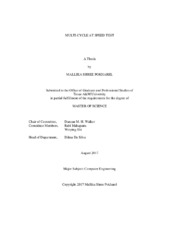| dc.description.abstract | In this research, we focus on the development of an algorithm that is used to generate a minimal number of patterns for path delay test of integrated circuits using the multi-cycle at-speed test. We test the circuits in functional mode, where multiple functional cycles follow after the test pattern scan-in operation. This approach increases the delay correlation between the scan and functional test, due to more functionally realistic power supply noise. We use multiple at-speed cycles to compact K-longest paths per gate tests, which reduces the number of scan patterns. After a path is generated, we try to place each path in the first pattern in the pattern pool. If the path does not fit due to conflicts, we attempt to place it in later functional cycles. This compaction approach retains the greedy nature of the original dynamic compaction algorithm where it will stop if the path fits into a pattern. If the path is not able to compact in any of the functional cycles of patterns in the pool, we generate a new pattern.
In this method, each path delay test is compared to at-speed patterns in the pool. The challenge is that the at-speed delay test in a given at-speed cycle must have its necessary value assignments set up in previous (preamble) cycles, and have the captured results propagated to a scan cell in the later (coda) cycles. For instance, if we consider three at-speed (capture) cycles after the scan-in operation, and if we need to place a fault in the first capture cycle, then we must generate it with two propagation cycles. In this case, we consider these propagation cycles as coda cycles, so the algorithm attempts to select the most observable path through them. Likewise, if we are placing the path test in the second capture cycle, then we need one preamble cycle and one coda cycle, and if we are placing the path test in the third capture cycle, we require two preamble cycles with no coda cycles. | en |


